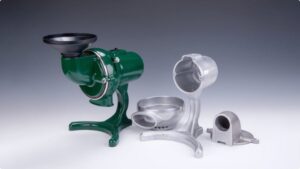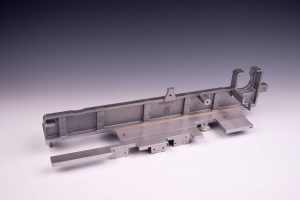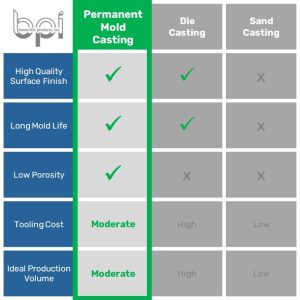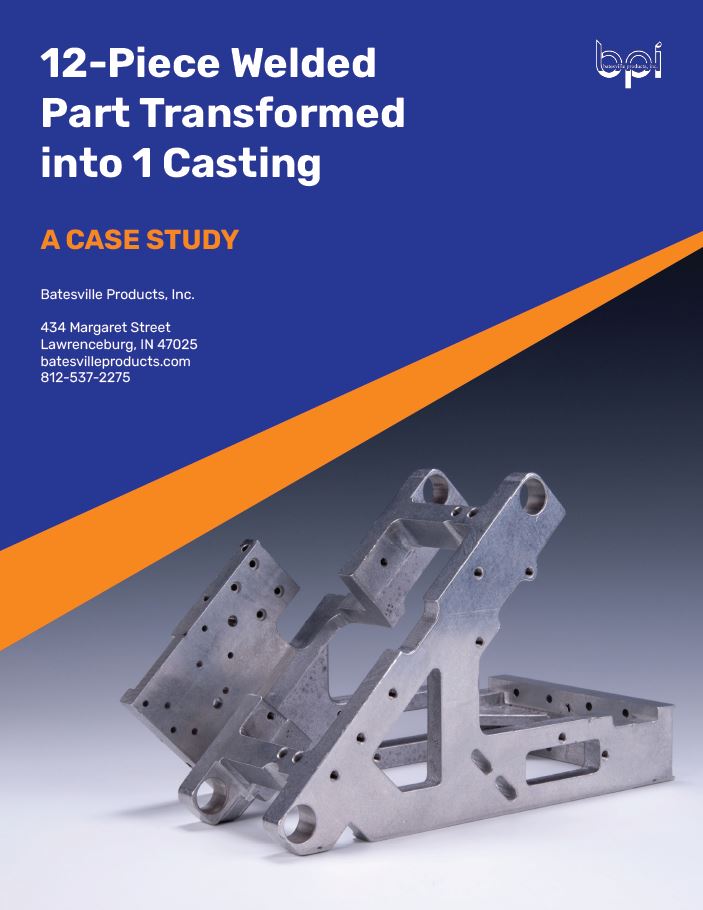What’s the best manufacturing method for my design? Listen to Rachel and Mary discuss the pros, cons, and when to use each process!
Lots of engineers come to us with a fabrication, wondering if it’s worth converting into a permanent mold casting. To determine the best manufacturing method for your design, consider these 6 factors.
The casting process can take 12 separately machined and welded pieces and turn them into one solid piece. But, is that practical for your design to function?
Do you have moving parts? Then you might turn your 12 fabricated pieces into 3 castings, or continue to fabricate.
Are you using mixed materials? Castings are limited to one material per part. At Batesville Products, we cast aluminum (A356) and zinc (ZA5 and ZA12.)

Both casting and fabrication can produce complex parts.
Permanent mold casting is great for unique, asymmetrical parts with lots of different walls and internal or external geometry. You can quickly create a repeatable, near-net shape. To add complexity, you can use different pulls, cores, and secondary machining. Here are some other casting design options that add complexity.
Fabrication can produce complex parts by machining and welding pieces together as many pieces as you want. However, keep in mind the more pieces you weld together, the higher the production cost and time.
If you’re making a simple rectangle or cube with a few drilled holes or threads, we recommend machining from stock. But, if your design has more geometry, start looking at casting. Depending on shape, size, and quantity, casting can increase efficiency and lower cost.

We’ve seen all kinds of shapes and sizes when it comes to castings and fabrications! But in general…
Permanent mold castings must have at least 0.18 inch wall thickness. Since the permanent mold process is gravity-fed and castings solidify quickly, a minimum wall thickness allows adequate metal flow. It’s also difficult to cast products with isolated thin or thick sections. In casting designs, we recommend gradual changes in wall thickness.
However, fabrications and machined products can have super thin walls and varying wall thicknesses. So ask yourself, is wall thickness a deal breaker for my design?
Are you making tiny keychains? These are best manufactured by CNC machining, not casting. Our permanent mold castings are typically 1 to 100 pounds. Again, the part must be the right size for proper metal flow and solidification.
Fabricated joints are potential weak spots. Castings are more structurally sound, being produced as one solid piece.
Quantity is one of the most important factors when deciding between fabrication and casting!
If you’re only manufacturing a couple pieces a year, fabrication will probably be your best option. If you’re fabricating 500 pieces a year or more, it’s time to start looking into casting.
If casting, you’ll need to invest in a tool or mold. Tooling cost can be anywhere from $5,000 to $500,000 depending on the casting process. Sand casting has the cheapest tool, making it a great introduction to the casting process for low-volume production. For moderate volume production, you’ll want to switch to permanent mold casting. Permanent mold castings have lower-porosity, and are more precise and repeatable than sand casting. For high-volume production, check out die casting.
Again, estimated annual usage (EAU) determines which manufacturing method is the most efficient and cost effective.

Producing a high quantity of fabricated parts means lots of welding labor time and cost. Sourcing multiple pieces means managing multiple drawings, coordinating purchasing and shipping, and extract inspection time.
Get quotes! The cost typically comes down to a balance between EAU and complexity. Do the benefits of one method add value to your product? What’s the ROI on a casting tool vs. machining and welding pieces together?
If you’re not sure where to start, ask trusted suppliers for advice. We look at parts like yours and answer manufacturing questions every day! We’ll help lead you to the best manufacturing method for your situation.
